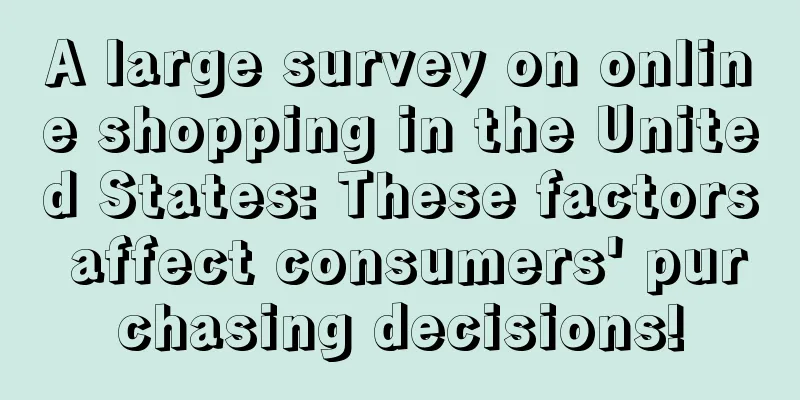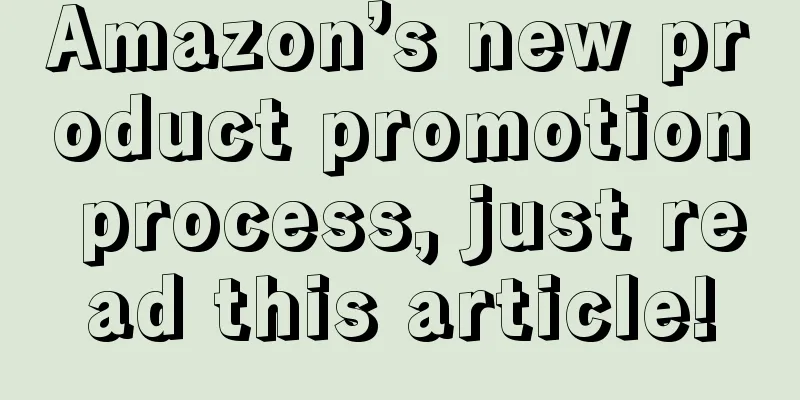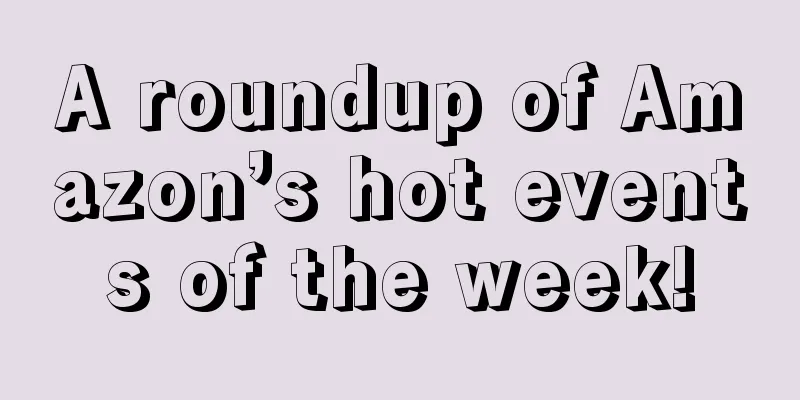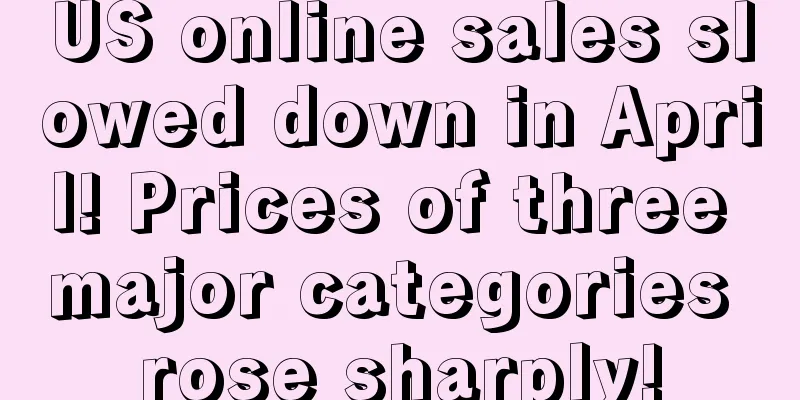Understanding Amazon Algorithm: How does the A9 algorithm affect the entire Amazon operation? How does Amazon's ranking mechanism work?

|
1. Principle of A9 Algorithm A9 Algorithm is actually a sorting algorithm. Simply put, it selects the most relevant products from Amazon's wide range of product categories and displays them to customers based on relevance. A9 algorithm focuses on product search and search result sorting. 2. Factors Affecting the Ranking of the A9 Algorithm The ranking factors of the A9 algorithm can be summarized into the following three aspects: 1. Relevance – meeting customer search needs; 2. Conversion rate – stimulate customers’ purchasing behavior; 3. Satisfaction & repurchase rate - bring the ultimate customer experience. 3. How Amazon’s ranking mechanism works Relevance + conversion rate = high ranking. The role of the A9 algorithm is to help Amazon calculate and recommend product rankings. Building Amazon rankings depends on two key factors: relevancy and conversions. The first factor (Relevancy) requires that the ranking be considered relevant by Amazon. For example, if you are selling slow cookers on Amazon, Amazon first needs to confirm that your product is a product related to the keyword Slow Cookers. If the two are not relevant, Amazon will not rank the product. The second factor (Conversions) is obviously better for product ranking. Once our product is considered relevant, the key to making it rank better is to create a listing with a high conversion rate. All other factors being equal, listings with higher conversion rates will often rank higher than those with lower conversion rates. 4. How to use the A9 algorithm correctly 1. Good products There are two core characteristics of a good product: first, high quality, and second, large user demand and relatively less intense competition. Seven points depend on product selection, and three points depend on operation. If you choose the right product, sales and ranking are not a problem. 2. Listing page optimization Page optimization mainly needs to start from the following aspects: pictures, titles, five points, descriptions, comments, Q&A, A+ pages, etc. The core of page optimization is: keyword research, rationally placing the main keywords, attribute words, and extended words related to the product in the above optimization projects, so that Amazon can recognize your products, allow customers to search for your products, and be attracted by your products and generate purchasing behavior. 3. After-sales Thoughtful after-sales service can enhance customers' experience, and needs to be optimized and strengthened in terms of order processing speed, controlling order defect rate and perfect order rate, and promptly responding to customer questions. 4. Advertising Amazon advertising is a relatively opportunistic way to improve rankings, but it is indeed a relatively fast way to increase exposure. Only when more people see your products will there be conversion rates, sales, and rankings. 5. Promotion Whether it is on-site promotion or off-site promotion, the essence of promotion may not be how much money you make. Its core goal is to increase your sales, get more VP Reviews, and then achieve the effect of improving ranking. With ranking, there will be more natural traffic. 5. How to improve product rankings 1. Create a highly relevant listing (1) Choose the correct product category In the past, many sellers might intentionally choose the wrong category with less competition to boost their category sales rank. However, this strategy is no longer effective and may actually lower your Amazon SEO. Many sellers know that Amazon products could have many categories/nodes in the past. However, now product categories/nodes are completely based on the product type keyword Item_Type_Keyword, and each product can only have one product type keyword. (2) Conduct effective keyword research There are many channels for researching Amazon keywords in the market, but here we have to thank the Amazon Advertising API for providing us with a backdoor that allows us to see the monthly search volume of keywords. Regarding keyword research, our biggest feeling is that it must be done before the product is launched on the shelves, so that we will have the opportunity to develop long-tail keyword products. The effect of keyword optimization after the product is launched will be minimal. 2. Create a high conversion rate listing (1) Display informative main images and videos Main pictures and videos are one of the best tools for creating high-converting listings, but they are also one of the links that most sellers easily mess up. At least four types of product main images are required in the listing: A. Product image with white background; B. Product information chart; C. Life scene pictures; D. Product specification drawing. One of the most amateur mistakes most sellers make is that they often use text information to describe the key features of the product in the five selling points and product details, but there is no text information in the most important product image. Video is also a very powerful conversion rate tool. Now Amazon has opened it to all sellers who have registered their brands. Telling a success story related to a product through video will greatly improve the effect. (2) Using A+ Pages Amazon claims that using A+ pages can increase the conversion rate of listings by about 10%. Therefore, on the surface, adding some creative design elements to our listings through A+ pages seems to greatly promote conversions. However, some sellers did not notice a significant difference in A/B testing of A+ pages. It seems that buyers do not often view content below the five selling points. Of course, this doesn’t mean that we don’t need A+ pages. We must use A+ pages. After all, it’s free. But don’t expect too much from A+ pages. (3) Create readable and click-through product titles When we enter any competitive Amazon product category, you will always find some product titles that are stuffed with keywords. Although Amazon keyword optimization is controversial, I still firmly believe that product titles should not be used only for Amazon SEO purposes but should be created to be more suitable for reading and more attractive for clicks. From an Amazon market research report in the figure below, we can see that the products with higher rankings have more concise titles. We can also include keywords in our product titles to help buyers find our products, but our ultimate goal is to entice them to click/buy our products as much as possible. (4) Increase sales speed Sales velocity is a bit like a black hole in theory: we know it exists and that it affects the ranking of listings, but we don't know how it works. But there seems to be a consensus: if our sales velocity continues to increase, then our ranking will be higher and faster. This also explains why it takes a long time for us to recover sales when our inventory is sold out, because our sales velocity basically starts from 0. At the same time, we need to note that 30 days of continuous sales are more effective than 1-2 days of quick sales. This strategy is more used when driving off-site traffic. For example, if you plan to promote a new product through EDM, it is better to divide the month into 4 stages instead of sending these promotional emails at once. (5) Conduct off-site traffic diversion Listings that bring in off-site sales will receive weight rewards and traffic recommendations. From the perspective of sales speed, it is also very necessary: if Amazon only allows you to run 0-60 yards, but when we drive traffic from outside the site, you can run much faster than 60 yards. Some proven Amazon traffic generation channels include: A. In-site customer emails; B. Facebook Ads - Landing Page; C. Your standalone page takes advantage of discounts and free products. One of the most effective ways to attract traffic from the site is through discounts and freebies, and Amazon openly allows us to create these discount and promotion options in the seller backend. As long as we don’t openly exchange reviews, offering free/discounted products is still a completely acceptable and still not outdated operation strategy. It will have the following positive effects: helping to increase sales (meaning faster sales speed) and increasing the chances of receiving reviews. But there are two problems with free/discounted products. The first problem is that products with a 25-50% discount will not be able to obtain VP reviews. Reviews that do not receive the VP mark cannot exist stably and will most likely be cleared in Amazon's next review. The second problem is that sales generated by offering free/discounted products off-site will not receive keyword conversion weighting because there is no data for these sales on Amazon. Of course, there are also some doubts that discounted/free sales just don’t get the same weighting as full-price sales. (6) Strive for the opportunity to be on the homepage Being on the homepage is a very positive listing ranking result. However, how many products can appear on the Amazon homepage depends on multiple factors, including: category, keywords, and equipment. Generally speaking, the number of products that can appear on the Amazon homepage ranges from 24 to 54, which means that a keyword ranking at #25 may sometimes be on the homepage, but sometimes it is embarrassing, so we must try our best to maintain #24 or even higher, so that we can attract more buyers' attention. |
Recommend
What is Micro Intelligence? Micro Intelligence Review
Micro Smart Tool is a cross-border e-commerce stor...
Post, find influencers, increase followers...all the Instagram tools you need are here!
With 700 million users, Instagram is a competitiv...
U.S. online sales are expected to grow 4% to $1.2 trillion in 2029
It is learned that according to Forrester's la...
Loss of 1 billion in one year! Is the well-known cross-border seller going out of business?
Written in front 2020 is destined to be an extrao...
What is chuangtengdata? chuangtengdata review
chuangtengdata mainly provides Amazon sellers with...
What is PriceMinister? PriceMinister Review
Priceminister (Rakuten France) was founded in Augu...
What is Fave? Fave Review
Fave Group is the fastest growing O2O company in S...
Amazon Advertising Case Study (I)
Q: I’m currently working on a product in a certai...
Multiple accounts are no longer linked?! Amazon updates its policy
Amazon has many strange policies that are difficul...
What is Yunnaqu.com? Yunnaqu.com Review
Yunnaqu.com - China's import and export logist...
What is BeautyMNL? BeautyMNL Review
BeautyMNL is a Philippine retail e-commerce platfo...
Germany's second-largest seller was also banned! The United States has just introduced the most stringent anti-counterfeiting measures for cross-border e-commerce
There is a saying circulating among cross-border s...
Will the [King Bomb] launched by TEMU become a new outlet? !
As a cross-border e-commerce platform under Pindu...
FBA inventory was stolen in large quantities! Sudden changes in Shenzhen affected shipments
In the past two days, the local police in the Uni...
Google's drone company Wing is about to exceed 100,000 deliveries!
<span data-shimo-docs="[[20,"获悉,谷歌母公司Alpha...









